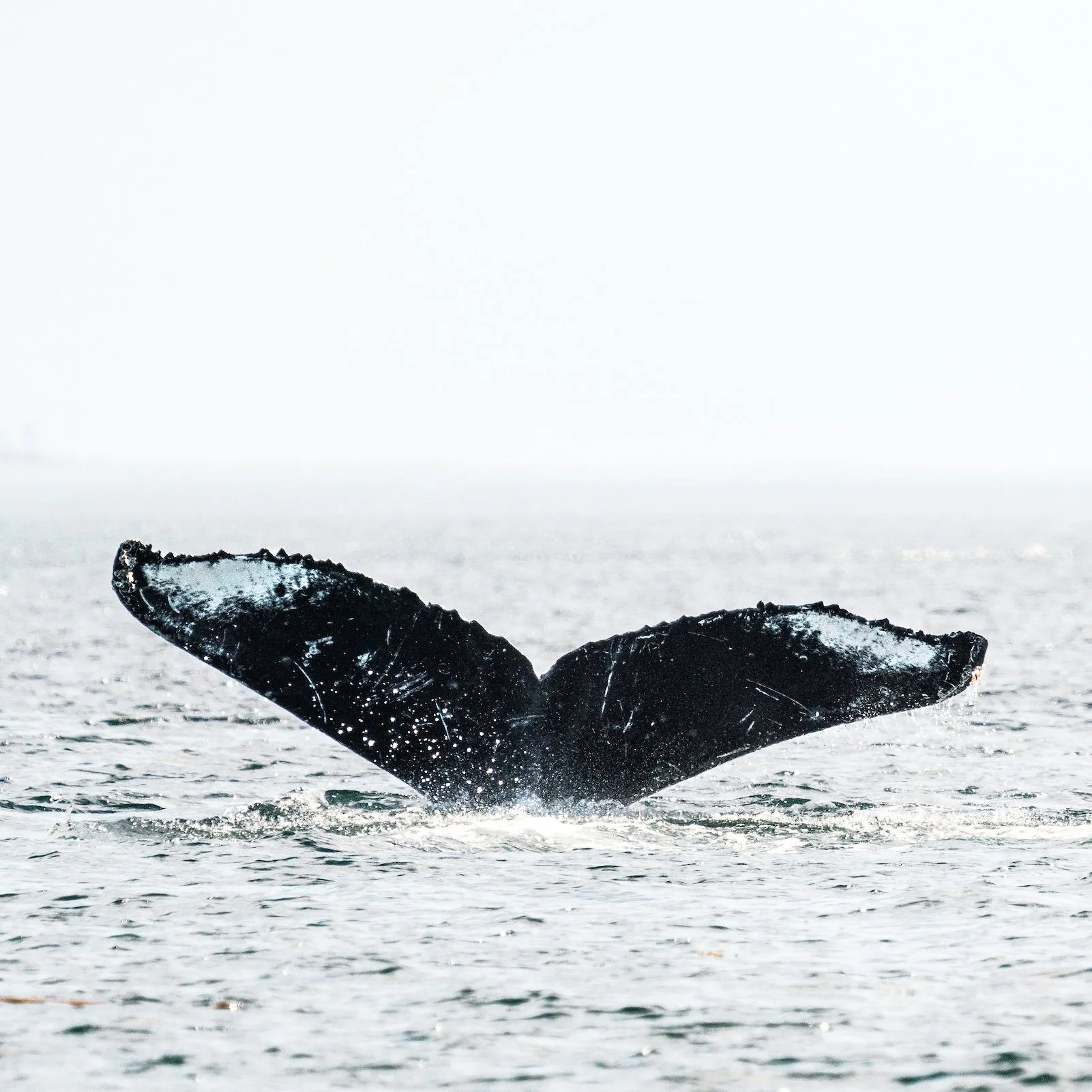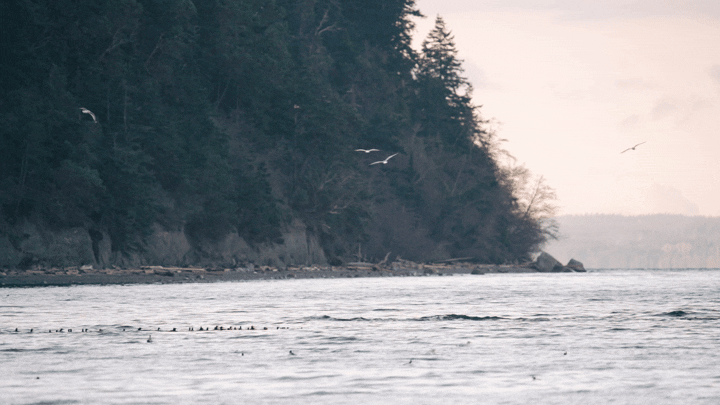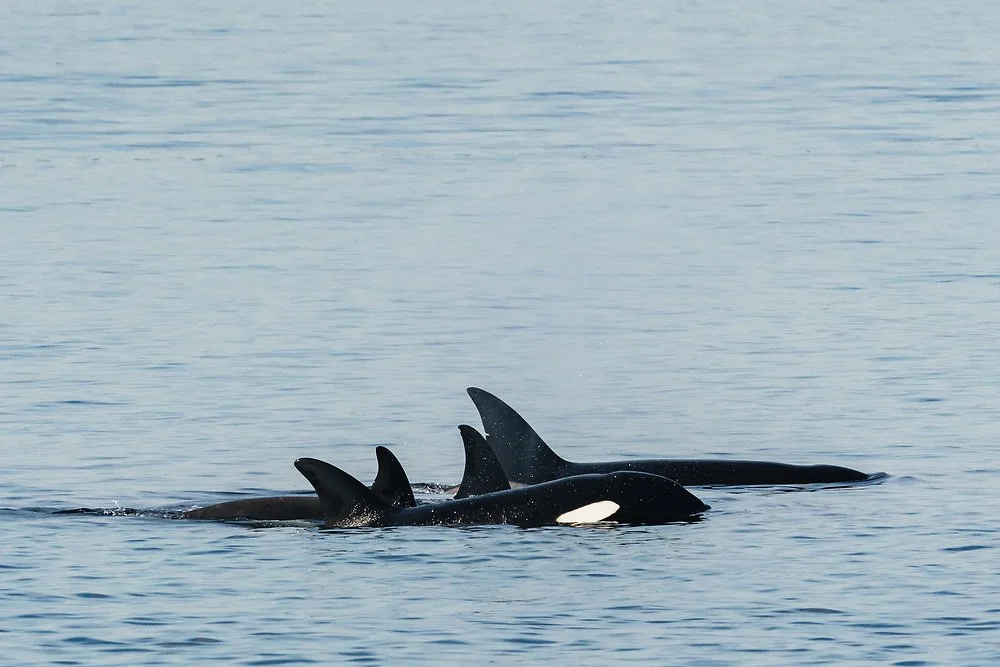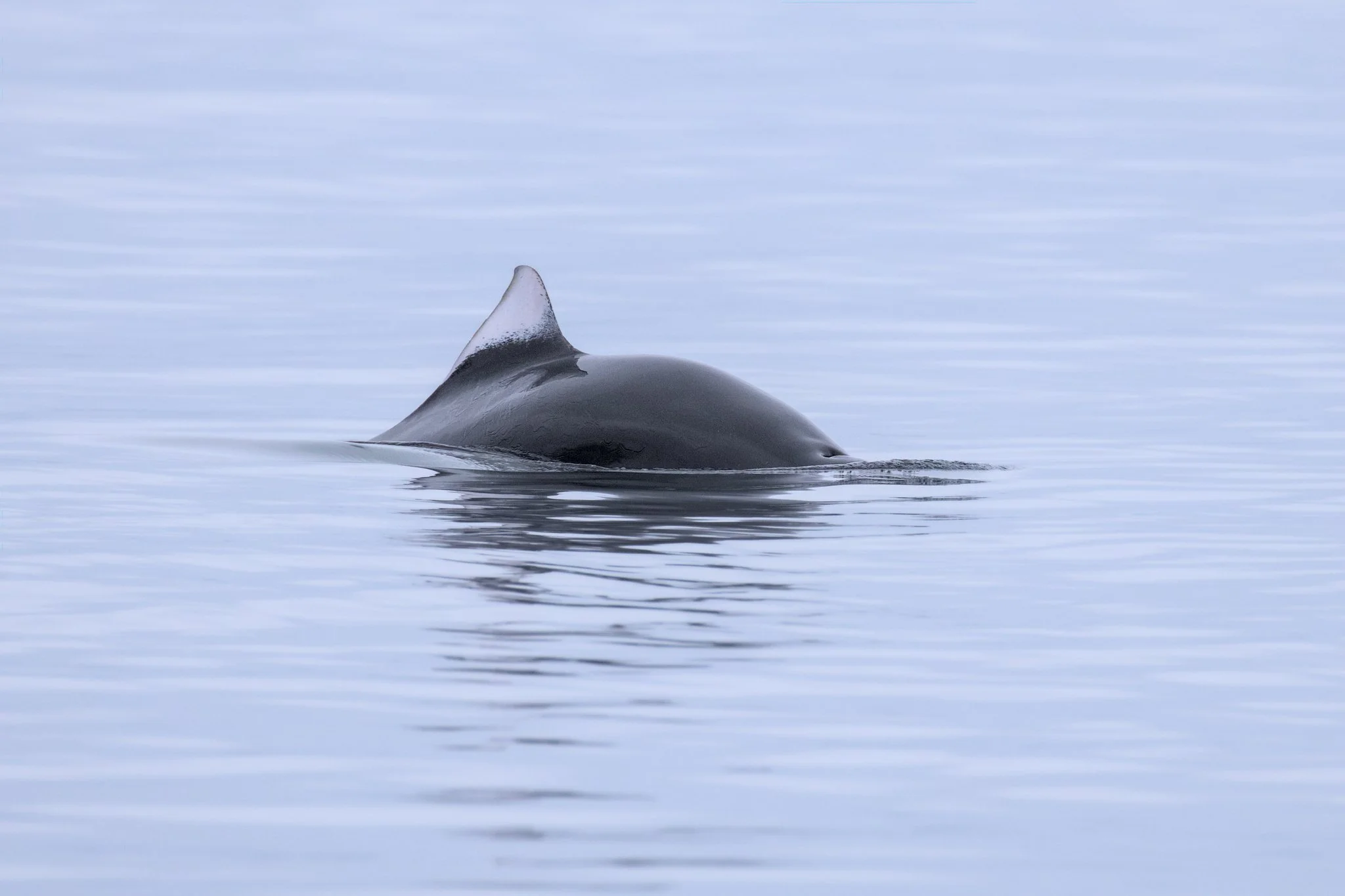Identifying the Types of Whales in Puget Sound
We’re lucky enough to have several species of whales that call Puget Sound home. It can be tricky to tell the difference between them, but once you know what to look for to differentiate between the different species it becomes easier and easier to consistently tell them apart.
If you saw something and still aren’t quite sure what it is feel free to reach out to us with photos and/or a description, or join our Discord server, and we’d be happy to help!
*While we adore the entire Salish Sea (of course!) with this identification guide we’re focusing specifically on whales that regularly appear in the waters of Puget Sound and we generally aren’t including species that tend to stay in the Northern Salish Sea (the Strait of Juan de Fuca, the San Juan Islands, the Strait of Georgia, etc) without traveling further south into the collective basins that make up Puget Sound proper.
BALEEN WHALES
Common Baleen Whales in Puget Sound
Humpback Whale
Scientific Name: Megaptera novaeangliae
Length: 40 — 50 feet
Weight: 50,000 — 80,000 pounds
Lifespan: 70+ years
Diet: Small bait fish
Frequency in Puget Sound: Common
Peak Months for Sightings: April — November
Description: In one of the most incredible wildlife conservation stories of our lifetime, after being extirpated locally by commercial whaling, Humpback Whales are now making an incredible comeback in the Salish Sea and more and more humpbacks are making their way further inland, deeper into the waters of Puget Sound proper.
Identifying Behavior: Humpbacks can be unpredictable and can pop up and change direction suddenly. If they’re traveling they’ll generally surface a handful of times and then do a deeper dive where they’ll show their flukes and disappear for a while, then pop back up again. Inland Puget Sound tends to see quite a few juvenile humpbacks so if you see a massive creature breach out of the Sound repeatedly you’re likely witnessing a playful young humpback
For more information on individual humpback whales of Puget Sound jump over to our Humpback Whale Guide
(Photo: Dave Hutchison)
Identification
Dorsal Fin
The dorsal fin that’s most similar to a humpback whale is a minke whale. The difference is that while a minke whale has a hook-shaped dorsal (kind of reminiscent of a dolphin dorsal fin) a humpback has a very irregular dorsal fin that will generally start with a little hump and end in a point. They also tend to make a dramatic bend in their body as they dive while a minke stays pretty streamlined at the surface
Fluke
Humpbacks have a pretty substantial, wide fluke that can vary in color from all black to all white. They show their flukes often and generally will do so right before they go on a big dive, meaning you might see their dorsal surface 3-5 times and then once you see their fluke they’re likely on a deeper dive and you won’t see them pop up again for 8-15 minutes (or never! They’re sneaky!)
Pectoral Fin
The pec fins of humpbacks are very long and skinny. Generally if you see them they’re making big, sweeping, dramatic actions like pec slapping on the water or waving them in the air
Gray Whale
Scientific Name: Eschrichtius robustus
Length: 40 — 50 feet
Weight: up to 90,000 pounds
Lifespan: 50 — 75 years
Diet: Ghost shrimp + other small invertebrates
Frequency in Puget Sound: Common
Peak Months for Sightings: February — June
Description: While there have been occasional gray whales in Puget Sound year round they primarily show up in the early spring and stay through mid-summer as they make a little stop-over in the middle of their migration from the lagoons in Baja California to their feeding grounds in the Arctic. There’s a beloved group of gray whales commonly referred to as “The Sounders” that have been showing up since 1990 and are a fascinating subsection of the Eastern North Pacific gray whales. These whales can commonly be seen feeding around the Snohomish Delta, Hat Island, Port Susan, Saratoga Passage, and Possession Sound. They also occasionally make their way south deeper into inland Puget Sound. These whales are so fun to view from shore because they tend to feed on ghost shrimp very close to the shoreline and they can stay in one location for an extended period of time.
For more information about the Sounders, and for help identifying individuals of this population, jump over to our Puget Sound Gray Whale guide.
(Photo: Sara Montour Lewis | Our Wild Puget Sound)
Identification
Dorsal Ridge
Unlike a humpback whale or a minke whale, gray whales don’t have a dorsal fin, but instead they have a flat dorsal ridge. The trailing edge has a series of bumps that looks like knuckles.
Also look for their mottled gray skin, which is a stark difference from the deep black uniform color of humpbacks + minkes
Fluke
Gray whale flukes are quite a bit narrower and more stout than a humpback whale.
Pectoral Fin
The pec fins of gray whales are very short compared to humpback whales. They’re pointed and ridged and can sometimes be hard to decipher between the fluke, especially because our Puget Sound gray whales tend to engage in a feeding strategy where they turn on their sides to feed, meaning you’re likely to see them with one pec fin and one side of their fluke out of the water
Blow
Gray whales have two blow holes, exhilations generally are heart-shaped and relatively low compared to the tall, singular blow of a humpback whale
Minke Whale
Scientific Name: Balaenoptera acutorostrata
Length: up to 35 feet
Weight: up to 20,000 pounds
Lifespan: ~50 years
Diet: Krill + small forage fish
Frequency in Puget Sound: Common
Peak Months for Sightings: April — October
Description: Minkes are the smallest baleen whales in North America and are elusive little creatures in Puget Sound, but are always a favorite to spot and have kind of a cult following with some naturalists. They’re one of the least studied whales in the Salish Sea and many mysteries surround them.
(Photo: Liam Singh)
Identification
Dorsal Fin
The dorsal fin of a minke whale is distinctly curved and looks more like an orca fin than a humpback. They have a sleek, uniformly dark gray top half of their body, which is what we commonly see as they surface, but the lower half of their body is much lighter and they have distinct white patches on their pec fins
Minkes very rarely show their flukes and also don’t usually have a discernible blow
(Photo: Liam Singh)
Uncommon + Rare Baleen Whale Species That Are Occasionally Spotted in Puget Sound
Fin Whale
Scientific Name: Balaenoptera physalus
Length: up to 85 feet
Weight: up to 100,000 pounds
Lifespan: ~90 years
Diet: Krill + small forage fish
Frequency in Puget Sound: Rare
Last seen in Puget Sound: 2022 in Shilshole Bay
Description: As the second largest whale in the world, and an endangered species, it’s notable when fin whales make their way into Puget Sound. It’s rare, but it does happen occasionally, including one that delighted spectators by hanging out in Shilshole Bay for a handful of days in 2022
(Photo: Leonardo Gonazalez)
Identification
Dorsal Fin
Fin whales, especially juvenile fin whales that are the ones that tend to find their way into the inland waters of Puget Sound, can be easily mistaken as a minke whale. Their dorsal fins and coloring is similar, but a fin whale is substantially larger
Fluke
Like a minke whale fin whales also rarely show their flukes
TOOTHED WHALES
Southern Resident Killer Whale
Scientific Name: Orcinus orca
Length: Up to 24 feet
Weight: Up to 15,000 pounds
Lifespan: Up to 100 years
Diet: Fish, with a heavy preference for Chinook salmon
Frequency in Puget Sound: Relatively common
Peak Months for Sightings: September - January — while the SRKWs can be seen in the Salish Sea year round they frequently spend longer lengths of time inland in Puget Sound in the fall months chasing the Chinook, Coho, and Chum Salmon runs. J Pod is known to spend the most amount of time here with occasional quick visits from K + L Pods. They’re also frequently seen around the San Juan Islands and the Northern Salish Sea throughout the summer, frequently passing very close to the west side of San Juan Island, sometimes feet from the lighthouse at Lime Kiln State Park
Description: The Southern Resident Killer Whales are endangered and if you’ve lived around the Sound you’ve likely heard of them and have maybe even fallen in love with them, too. They’re as charismatic as can be and are hard not to adore. They eat fish, primarily salmon, and are generally seen in large pods of 15 - 30 individuals (sometimes they’re sen in super pods of all three groups — J, K, and L pods — which can be 70+ individuals). The size of the pod is one hint that’s helpful in figuring out if you’re looking at Southern Resident Killer Whales or Bigg’s Killer Whales, which generally traveling in groups of around 4-8, but Bigg’s can also gather in larger groups so it isn’t a completely fail safe identification tool. Use the physical descriptions below as another tool for identification
Identification Tips: Unless they’re being really surface active what you’ll generally see with orcas is their dorsal fin rhythmically coming up out of the water and then disappearing. They’re pretty consistent and generally travel in one direction more dependably than baleen whales (so if you hear that they’re in one place, going in a certain direction, it’s a great idea to find a spot on the water a couple miles ahead of them to spot them as they pass by!).
Orca Imposters: If you’re seeing something that looks like an orca fin but it’s sitting on top of the water without going under it’s likely either a sea lion warming up on the surface of the water by sticking its fins in the air (a process called thermoregulation) or it’s a deceptively orca-like piece of driftwood (we have hundreds of photos of driftwood that we thought for SURE was a whale. You aren’t alone here! 😉). If you see a small, triangular dorsal fin surface a couple of times and then disappear (sometimes in small groups of 3-5 or so) you’re likely seeing an adorable harbor porpoise (more about them below!).
For more information on the Southern Resident Killer Whales, including help identifying individuals, head over to our Southern Resident Killer Whale Guide
(Photo: Sara Montour Lewis | Our Wild Puget Sound)
Dorsal Fin + Saddle Patch
Southern Resident Killer Whales tend to have what’s called an open saddle patch, meaning that the lighter coloring below their dorsal fin may be broken up by some pockets of darker coloring, whereas Bigg’s Killer Whales will generally have a uniform, solid light-colored saddle patch
Southern Resident Killer Whales also generally have a dorsal fin with a rounded tip while Bigg’s Killer Whales are known to have pointier dorsal fins. Dorsal fins can range in size from small hook-shaped dorsals seen on young killer whales (similar to a minke whale!) to the gigantic 6-foot tall dorsal fins of adult males
(Photo: K43/Saturna by Sara Montour Lewis | Our Wild Puget Sound)
Eye Patch
The differences between the eye patches in Southern Residents vs Bigg’s Killer Whales is subtle and isn’t always fully dependable for identification, but in general the eye patches of the Southern Residents tend to run parallel to the body or point slightly upwards while the eye patches of Bigg’s tend to angle downwards
(Photo: Sara Montour Lewis | Our Wild Puget Sound)
Bigg’s Killer Whale
Scientific Name: Orcinus orca
Length: Up to 27 feet
Weight: Up to 20,000 pounds
Lifespan: Up to 100 years
Diet: Marine mammals like harbor seals, harbor porpoise, and sea lions
Frequency in Puget Sound: Common
Peak Months for Sightings: Year Round
Description: Unlike the endangered Southern Resident Killer Whales who are struggling to maintain their population, Bigg’s Killer Whales (also known as Transient Killer Whales) are thriving. The abundance of marine mammals has kept them well fed and they’re now frequently seen around Puget Sound year round, providing the key to a great balance for the ecosystem. Southern Resident Killer Whales are generally seen in large pods of 15 - 30 individuals (sometimes they’re sen in super pods of all three groups — J, K, and L pods — which can be 70+ individuals). The size of the pod is one hint that’s helpful in figuring out if you’re looking at Southern Resident Killer Whales or Bigg’s Killer Whales, which generally traveling in groups of around 4-8, but Bigg’s can also gather in larger groups so it isn’t a completely fail safe identification tool. Use the physical descriptions below as another tool for identification
Identification Tips: Unless they’re being really surface active what you’ll generally see with orcas is their dorsal fin rhythmically coming up out of the water and then disappearing. They’re pretty consistent and generally travel in one direction more dependably than baleen whales (so if you hear that they’re in one place, going in a certain direction, it’s a great idea to find a spot on the water a couple miles ahead of them to spot them as they pass by!).
Orca Imposters: If you’re seeing something that looks like an orca fin but it’s sitting on top of the water without going under it’s likely either a sea lion warming up on the surface of the water by sticking its fins in the air (a process called thermoregulation) or it’s a deceptively orca-like piece of driftwood (we have hundreds of photos of driftwood that we thought for SURE was a whale. You aren’t alone here! 😉). If you see a small, triangular dorsal fin surface a couple of times and then disappear (sometimes in small groups of 3-5 or so) you’re likely seeing an adorable harbor porpoise (more about them below!).
For more information on Bigg’s Killer Whales, including help identifying individuals, head over to our Bigg’s Killer Whale Guide
(Photo: Sara Montour Lewis | Our Wild Puget Sound)
Dorsal Fin + Saddle Patch
Southern Resident Killer Whales tend to have what’s called an open saddle patch, meaning that the lighter coloring below their dorsal fin may be broken up by some pockets of darker coloring, whereas Bigg’s Killer Whales will generally have a uniform, solid light-colored saddle patch
Southern Resident Killer Whales also generally have a dorsal fin with a rounded tip while Bigg’s Killer Whales are known to have pointier dorsal fins. Dorsal fins can range in size from small hook-shaped dorsals seen on young killer whales (similar to a minke whale!) to the gigantic 6-foot tall dorsal fins of adult males
(Photo: T037B/Harald by Sara Montour Lewis | Our Wild Puget Sound)
Eye Patch
The differences between the eye patches in Southern Residents vs Bigg’s Killer Whales is subtle and isn’t always fully dependable for identification, but in general the eye patches of the Southern Residents tend to run parallel to the body or point slightly upwards while the eye patches of Bigg’s tend to angle downwards
(Photo: T036B2/Greenfelder by Sara Montour Lewis | Our Wild Puget Sound)
Harbor Porpoise
Scientific Name: Phocoena phocoena
Length: Up to 6 ft
Weight: Up to 170 pounds
Lifespan: Up to 20 years, generally 8-12 years
Diet: Harbor porpoises are opportunistic feeders that generally seek out small schooling fish, but they’ve also been seen eating fish as big as salmon in the Salish Sea and have been known to eat cephalopods and crustaceans
Frequency in Puget Sound: Common
Peak Months for Sightings: Year round
Description: Harbor porpoises are the smallest cetaceans in Puget Sound and are frequently seen in small groups. They have a tricky tendency to appear suddenly, surface a few times, and then disappear the second you have your camera ready.
(Photo: Solvin Zankl)
Dorsal Fin
Harbor porpoises generally surface very quickly and you’ll likely catch a quick glimpse of their small, triangular dorsal fin before they disappear again
(Photo: Sara Montour Lewis | Our Wild Puget Sound)
Uncommon + Rare Toothed Whale Species That Are Occasionally Spotted in Puget Sound
*There have been occasional instances of beluga, common dolphins, bottlenose dolphins, and other species in Puget Sound, but those are so rare that we haven’t included them in this guide
Pacific White-sided Dolphin
Scientific Name: Lagenorhynchus obliquidens
Length: Up to 8 feet
Weight: Up to 400 pounds
Lifespan: Up to 40 years
Diet: Lags are opportunistic feeds and will generally feed on small schooling fish, squid, and crustaceans
Frequency in Puget Sound: Uncommon
Recent sightings in Puget Sound: December 22, 2024 in Admiralty Inlet + May 28, 2024 in Penn Cove
Description: Known to a lot of people as ‘lags’ for their scientific name, Pacific white-sided dolphins are uncommon, but exciting, visitors to inland Puget Sound. They frequently travel quickly in large schools and bring a lot of energy with them.
(Photo: Alex Lamoreaux)
Dall’s Porpoise
Scientific Name: Phocoenoides dalli
Length: Up to 8 feet
Weight: Up to 450 pounds
Lifespan: Up to 20 years
Diet: Dall’s are opportunistic feeds and will generally feed on small schooling fish, squid, and crustaceans
Frequency in Puget Sound: Increasingly rare
Recent sightings in Puget Sound: May 2018 in Hood Canal [video]
Description: Dall’s porpoises used to be more common in Puget Sound but sightings of them have decreased as the harbor porpoise population has increased. Dall’s are usually seen in small groups and are very fast. Sometimes the only glimpse you see of them is the rooster tail of water they leave behind as they zoom by.





























